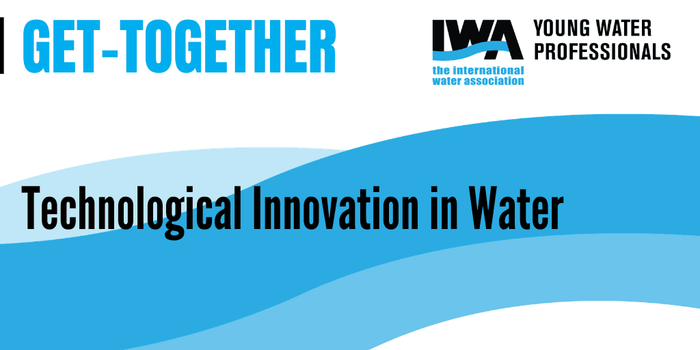Young Water Leaders on Technological Innovation in Water

Published on Nov 20, 2020
The IWA Emerging Water Leaders Steering Committee held an online discussion with the IWA Young Water Professionals on 11 November 2020. This gave attendees an opportunity to meet peers and exchange ideas on topics relevant to their work as water professionals, as well as on the future of the water sector, and much more. The third edition was focused on technological innovations in water.
Technological innovation is crucial to fulfilling needs of the constantly changing modern world, and the water sector is no exception. Nowadays, young water professionals strive to find solutions to the challenges we face, and contribute in attempts to achieve a water-wise world.
Overall, 61 participants from 34 countries participated, exchanging knowledge and information about their experiences. The IWA Young Water Professionals, who represent industry, academia and utilities, discussed how to best tackle the challenge of innovation in the sector. They all brought their own viewpoints, identifying agile approach practices as the key to being successful.
The discussion was moderated by Suvritha Ramphal (JG Afrika (Pty) Ltd, South Africa). The panellists were as follows:
- Thor Danielsen (HOFOR A/S, Denmark),
- Conall Holohan (NVP Energy and Technology Development at National University of Ireland),
- Emma Weisbord (Royal Haskoning DHV, Netherlands),
- Xiaoyuan Zhang (Tsinghua University, China).
The panellists shared their insights on technological innovation in water around the following key themes:
- Profitable strategies incorporated within partnerships, and collaboration between industry, consultancy, and academia, which are paramount for fruitful technological innovation.
- Mutual sharing and exploring of important activities undertaken by YWPs on the journey to technological innovation in water.
- Recognition of knowledge sharing around digitalisation as a crucial part of future technological innovation.
What are the profitable strategies incorporated within partnerships, and collaboration between industry, consultancy and academia, which are paramount for fruitful technological innovation?
Thor Danielsen, representing a utility sector which is responsible for the digital wastewater business units, shared: “the company I represent is at the end of the value chain, and so it is crucial for us to partner up with organisations representing other sectors. We concentrate on four key points: 1. Utilising and acknowledging the different purposes for technology innovation. 2. Formalizing collaboration. 3. Entering with an open mind, bearing in mind that utilities usually do not compete with each other. 4. Backing from the executive level is crucial to creating momentum”.
Conall Holohan, having worked across academia and industry, stated, “Starting off from the academic point of view, we thoroughly investigated the industry and saw what was needed on the ground when it comes to wastewater treatment. We went from an applied point of view towards piloting, at the same time leaning on cross-sectoral connections and utilising that knowledge. We were simultaneously producing fundamental data, from a microbiological point of view, and investing in engineering solutions. The challenge we faced was how to demonstrate the outcomes and provide verification”. Conall revealed that cross-sectorial collaborations lead to stronger and more durable technological innovation.
Suvritha Ramphal, who has had conversations with lab representatives of the pollution research group at one of South Africa’s universities added, “Recognizing the importance of cooperation continues a good relationship, as the reality is that a prototype created together needs to find an outlet to be implemented”.
What mutual sharing and important activity is played by YWPs on the journey to technological innovation in water?
Emma Weisbord enthusiastically said, “It all comes down to how we apply our knowledge to technical purposes. As YWPs, we all have a fundamental role to play through digital transformation, which will enable us to develop scale. An agile approach is crucial to the role of YWPs on the journey to digital transformation. This comes down to an elementary architectural shift on how the world works, recognising that we are moving from a societal hierarchy to peer-to-peer networks. The crucial point for me is that networks enable collective intelligence to flourish and we need this collective intelligence to solve water challenges at scale”.
How do we attract YWPs to networks?
Xiaoyuan Zhang admitted, “In the China YWP Chapter we have many collaborations, however they are dominated by professionals representing research and academia. We need greater inclusivity to build up a better network. Our strategy has been so far to recruit charismatic young professionals to become our members and have them involved in online gatherings to discuss important topics and to keep inspiring one another”.
Emma Weisbord summed up, “The water sector faces challenges and one of them is branding. It is certain that we need diversity to develop innovation and we need innovation to attract a broader range of people with diverse backgrounds. It is crucial to continuously be more vocal about what exciting things are happening, in order to actively attract more diverse professionals to the water sector. Drawing people from different backgrounds, such as data scientists, engineers, and cross-industry representatives, is the key. We have a tremendous opportunity to become a fundamental sector for the development of people across the world”.
About the IWA Young Water Professional community
IWA empowers Young Water Professionals within the Association and the water sector. IWA Young Water Professionals are all IWA members aged 35 and below. The IWA gives them a platform to develop their professional network, to connect and contribute to the Association and the water sector, and to join their local IWA YPW group. Through their engagement – e.g. in IWA Specialist Groups – IWA Young Water Professionals are able develop professionally and boost their profile.
